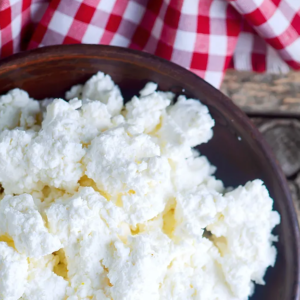Once a Dairy Darling, Cottage Cheese Makes a Comeback

As far back as I can remember, I’ve always liked cottage cheese—though I believe I was the only one in my family, other than my mom, who did. But after some reflection, I think it wasn’t so much that she really enjoyed it, but rather that cottage cheese—with fruit, on toast, or alongside a burger patty—was a popular diet food (especially in the ’60s and ’70s). And it seemed she was always on a diet, though only God  knows why.
knows why.
While the exact origin of cheese remains somewhat mysterious, it likely began by accident over a millennium ago, when Neolithic goat farmers stored milk in pouches made from animal stomachs. These pouches contained traces of the enzyme rennet, which caused the milk to curdle into curds and whey. They soon discovered that by draining off the whey, the curds could be pressed into a solid, edible mass.
Evidence suggests that cheesemaking quickly spread throughout the ancient world. First the Egyptians, then the Greeks, and later the Romans developed their own varieties. By the time of Julius Caesar, hundreds of  different cheeses were being produced throughout the empire and beyond. Cheese was so valued it was sometimes even used as currency.
different cheeses were being produced throughout the empire and beyond. Cheese was so valued it was sometimes even used as currency.
During the Middle Ages, monks in monasteries across Europe refined cheesemaking techniques, developing even more varieties—many of which we still enjoy today. For example, Gorgonzola was first made by Italian monks in 879 AD, and French monasteries recorded the making of Roquefort as early as 1070.
However, cheesemaking didn’t reach America until the 17th century with the arrival of European immigrants. These settlers brought with them the tradition of making fresh farmhouse cheeses from naturally soured leftover milk.
 Cottage cheese—a fresh cheese with a mild, slightly sour flavor—is thought to be the first cheese made in America. As early as the 1830s, German, Norwegian, and Swiss immigrants settled in various Wisconsin communities and quickly began producing farmhouse cheese. At the time, cheesemaking was primarily women’s work on the farm, as was tending the cattle, while the men focused on crops like wheat and barley.
Cottage cheese—a fresh cheese with a mild, slightly sour flavor—is thought to be the first cheese made in America. As early as the 1830s, German, Norwegian, and Swiss immigrants settled in various Wisconsin communities and quickly began producing farmhouse cheese. At the time, cheesemaking was primarily women’s work on the farm, as was tending the cattle, while the men focused on crops like wheat and barley.
In 1841, Mrs. Anne Pickett established the first “cottage industry” cheese factory, operated from her home near Lake Mills in Jefferson County, Wisconsin, using milk from neighbors’ cows. Over the next twenty-five years, small farmstead cheese cooperatives like Mrs. Pickett’s continued to grow. By 1899, Wisconsin boasted more than 1,500 of these factories, making it the second-largest cheese-producing state behind New York.
By the mid-1800s, the term “cottage cheese” had begun to describe simple, farm-made cheese, and by 1868, the first American industrial cheese factory had opened. The popularity of factory-made cheese  continued to grow across the United States, and by the turn of the 20th century, overall cheese production—including cottage cheese—had increased significantly.
continued to grow across the United States, and by the turn of the 20th century, overall cheese production—including cottage cheese—had increased significantly.
During World War I, cottage cheese and other dairy products were heavily promoted to conserve meat for military rations. One widely distributed poster claimed that pound for pound, cottage cheese contained more protein than lamb, pork, beef, or chicken. These campaigns had a lasting impact. In 1919, one year after the war ended, cottage cheese accounted for 7.4 percent of total U.S. cheese production. By 1928, that figure had nearly tripled to almost 21 percent.
 Cottage cheese consumption peaked in the 1970s during the dieting craze, with the average American eating 4.6 pounds of it annually. But within a decade, yogurt began to replace it as the “healthier” diet food, and cottage cheese sales declined steadily—dropping to less than 2 pounds per person.
Cottage cheese consumption peaked in the 1970s during the dieting craze, with the average American eating 4.6 pounds of it annually. But within a decade, yogurt began to replace it as the “healthier” diet food, and cottage cheese sales declined steadily—dropping to less than 2 pounds per person.
Then in 2017, the cottage cheese market began to enjoy slow but steady growth, as producers focused on improving quality and consumers started returning to “real food.” By 2023, cottage cheese had exploded in popularity, thanks in part to TikTok and other social media platforms  showcasing creative ways to use this protein powerhouse. People began adding it to baked goods, pastas, eggs, smoothies, sandwiches, and more—all while touting its nutritional benefits.
showcasing creative ways to use this protein powerhouse. People began adding it to baked goods, pastas, eggs, smoothies, sandwiches, and more—all while touting its nutritional benefits.
Since the 2023–2024 boom, the cottage cheese market—alongside other cultured dairy products—has grown by more than 18 percent year over year, with no signs of slowing down.




I like what you guys are up too. Such clever work and reporting! Keep up the superb works guys I’ve incorporated you guys to my blogroll. I think it will improve the value of my website 🙂
Another great and informative article! My wife enjoys cottage cheese with some pineapple mixed in, I prefer a dash of seasoned salt – try it!